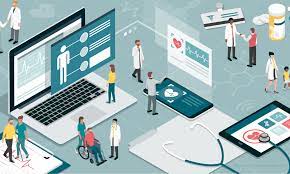
The intersection of technology and healthcare has given rise to revolutionary changes in the way medical services are delivered. Telehealth, a subset of healthcare technology, has emerged as a powerful tool in improving access, efficiency, and quality of healthcare services. This article explores the various aspects of telehealth and its significant contributions to healthcare technology.
Telehealth Overview
Telehealth refers to the use of digital information and communication technologies to provide and support healthcare services remotely. It encompasses a broad range of applications, including telemedicine, remote patient monitoring, and virtual consultations. The primary goal of telehealth is to overcome geographical barriers, improve patient outcomes, and enhance the overall healthcare experience.
Technological Foundations of Telehealth
Internet Connectivity
Central to the success of telehealth is reliable and high-speed internet connectivity. The availability of broadband services ensures seamless communication between healthcare providers and patients. As global internet infrastructure continues to advance, telehealth becomes more accessible to diverse populations, including those in remote and underserved areas.
Digital Devices and Wearables
The proliferation of smartphones, tablets, and wearable devices has significantly contributed to the expansion of telehealth. These devices enable patients to monitor their health, track vital signs, and share real-time data with healthcare professionals. Wearables, such as fitness trackers and smartwatches, have become instrumental in preventive healthcare and early detection of potential issues.
Health Information Exchange (HIE)
Health Information Exchange facilitates the secure sharing of patient information among healthcare providers. This interoperability is crucial for telehealth, ensuring that relevant data is available to inform medical decisions. Seamless integration of electronic health records (EHRs) allows healthcare professionals to access comprehensive patient histories, leading to more informed diagnoses and treatment plans.
Remote Patient Monitoring
One of the key contributions of telehealth is in the realm of remote patient monitoring (RPM). Through connected devices and wearables, healthcare providers can remotely monitor patients’ vital signs, chronic conditions, and overall health status. This proactive approach allows for early intervention, reducing hospitalizations and improving patient outcomes.
Telehealth in Chronic Disease Management
Telehealth plays a pivotal role in the management of chronic diseases. Patients with conditions such as diabetes, hypertension, and heart disease can benefit from regular monitoring and virtual consultations. Telehealth interventions empower individuals to actively participate in their care, leading to better adherence to treatment plans and improved long-term health outcomes.
Telehealth in Rural and Underserved Areas
One of the significant challenges in healthcare is the disparity in access, particularly in rural and underserved areas. Telehealth bridges this gap by providing remote access to healthcare services. Patients in remote locations can connect with healthcare professionals without the need for extensive travel, thereby improving their access to timely and quality care.
Virtual Consultations and Telemedicine Platforms
Virtual consultations have become a cornerstone of telehealth, offering a convenient and efficient way for patients to consult with healthcare providers. Telemedicine platforms enable real-time video conferencing, secure messaging, and sharing of medical information. This approach not only enhances accessibility but also reduces the burden on physical healthcare facilities.
The Impact of Telehealth on Healthcare Access
The widespread adoption of telehealth has significantly increased healthcare access for millions of individuals. Patients no longer face barriers such as distance, transportation, or mobility issues when seeking medical advice. This improved access is particularly critical in emergency situations, where timely intervention can make a substantial difference in outcomes.
Challenges and Concerns in Telehealth Implementation
Despite its many advantages, the implementation of telehealth is not without challenges. Addressing these concerns is essential for ensuring the widespread and equitable adoption of telehealth services.
Security and Privacy
The transmission of sensitive health information over digital networks raises concerns about data security and patient privacy. Telehealth platforms must adhere to robust security standards to protect patient confidentiality and comply with regulatory requirements.
Regulatory and Legal Considerations
The evolving nature of telehealth often outpaces existing regulations and legal frameworks. Policymakers must continuously update and adapt regulations to address issues such as licensure, reimbursement, and liability in the context of telehealth services.
Technology Literacy and Access
Not all individuals have the same level of access to technology or the digital literacy required for effective use of telehealth services. Bridging the digital divide is essential to ensure that telehealth benefits are accessible to all demographic groups.
Future Trends in Telehealth
The future of telehealth holds exciting possibilities as technology continues to advance. Emerging trends include the integration of artificial intelligence (AI) for predictive analytics, the use of virtual reality (VR) for immersive healthcare experiences, and the expansion of telehealth services into specialized fields such as mental health and dermatology.
Telehealth and Public Health Initiatives
Telehealth has played a pivotal role in supporting public health initiatives, especially during global health crises. The COVID-19 pandemic underscored the importance of telehealth in maintaining continuity of care while minimizing the risk of virus transmission. Telehealth services, including remote consultations and virtual monitoring, became essential tools for managing the pandemic by enabling healthcare providers to safely interact with patients.
Telehealth in Mental Health Care
The integration of telehealth into mental health services has been a significant advancement. Virtual therapy sessions, counseling, and mental health monitoring have become more accessible, breaking down barriers associated with stigma and accessibility. Telepsychiatry, in particular, has proven to be an effective means of reaching individuals who may otherwise face challenges in seeking mental health support.
Telehealth and Healthcare Equity
Telehealth has the potential to address healthcare disparities by improving access for vulnerable populations. Minority communities, individuals with disabilities, and those with limited resources stand to benefit from telehealth interventions. Efforts to ensure cultural competence and linguistic diversity in telehealth services contribute to a more equitable healthcare landscape.
Telehealth as a Tool for Health Education
Beyond consultations and monitoring, telehealth serves as a valuable tool for health education. Patients can access educational resources, participate in virtual wellness programs, and receive personalized health information through telehealth platforms. This empowers individuals to take proactive steps in managing their health and preventing illness.
Collaboration and Interdisciplinary Care
Telehealth facilitates collaboration among healthcare professionals, fostering interdisciplinary care. Specialists can remotely consult with primary care physicians, share expertise, and collectively contribute to patient care. This collaborative approach enhances the overall quality of healthcare services, especially in complex medical cases.
Data Analytics and Population Health Management
The data generated through telehealth platforms contribute to robust analytics and population health management. Healthcare providers can use this data to identify trends, track health outcomes, and implement targeted interventions. Predictive analytics enable proactive healthcare strategies, reducing the burden on emergency services and preventing the escalation of health issues.
Telehealth and Emergency Response
In emergency situations, telehealth plays a crucial role in triaging patients, providing initial assessments, and coordinating emergency response efforts. Remote consultations allow healthcare professionals to assess the severity of a situation, guide patients on necessary actions, and facilitate timely transfers to medical facilities when required.
Evolving Payment and Reimbursement Models
The integration of telehealth has prompted a reevaluation of payment and reimbursement models in healthcare. Policymakers and insurance providers are exploring ways to ensure fair compensation for telehealth services, incentivizing healthcare providers to embrace this mode of care delivery. Addressing financial considerations is essential for the sustainable growth of telehealth.
International Collaboration and Telehealth Adoption
Telehealth has the potential to facilitate international collaboration in healthcare. The exchange of medical expertise across borders, consultation with specialists in different countries, and sharing best practices contribute to a more globally connected healthcare ecosystem. Standardizing telehealth practices internationally can enhance its effectiveness and broaden its impact.
Ethical Considerations in Telehealth
As telehealth becomes more prevalent, ethical considerations come to the forefront. Issues such as informed consent, patient autonomy, and the responsible use of technology must be carefully navigated. Maintaining a balance between leveraging technology for improved healthcare and upholding ethical standards is crucial in the evolving landscape of telehealth.
Public Perception and Patient Satisfaction
Understanding public perception and patient satisfaction is integral to the successful integration of telehealth into mainstream healthcare. Continuous feedback, addressing user experience concerns, and promoting awareness of the benefits of telehealth contribute to building trust and fostering a positive attitude towards these innovative healthcare solutions.
Conclusion
In conclusion, telehealth stands as a transformative force in healthcare technology, offering innovative solutions to longstanding challenges. From improving healthcare access in remote areas to revolutionizing chronic disease management, telehealth’s impact is profound. As technology continues to evolve, the integration of telehealth services will likely become even more seamless, ushering in a new era of patient-centered, accessible, and efficient healthcare. Embracing and overcoming the challenges associated with telehealth will be crucial in unlocking its full potential for the benefit of individuals and the healthcare system as a whole.



